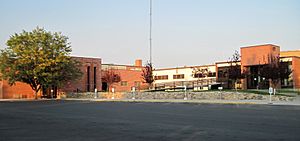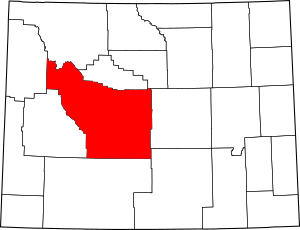Fremont County, Wyoming facts for kids
Quick facts for kids
Fremont County
|
|
|---|---|

Fremont County Courthouse in Lander
|
|

Location within the U.S. state of Wyoming
|
|
 Wyoming's location within the U.S. |
|
| Country | |
| State | |
| Founded | March 5, 1884 |
| Named for | John C. Frémont |
| Seat | Lander |
| Largest city | Riverton |
| Area | |
| • Total | 9,266 sq mi (24,000 km2) |
| • Land | 9,184 sq mi (23,790 km2) |
| • Water | 82 sq mi (210 km2) 0.9%% |
| Population
(2020)
|
|
| • Total | 39,234 |
| • Density | 4.23419/sq mi (1.63483/km2) |
| Time zone | UTC−7 (Mountain) |
| • Summer (DST) | UTC−6 (MDT) |
| Congressional district | At-large |
Fremont County is a county located in the state of Wyoming in the United States. In 2020, about 39,234 people lived here. This makes it the fifth-most populated county in Wyoming. The main town, or county seat, is Lander.
The county was started in 1884. It is named after John C. Frémont, who was a general, explorer, and politician. Fremont County is almost as big as the entire state of Vermont. The area around Riverton in Fremont County is known as a Micropolitan Statistical Area. This means it's a smaller city area with close ties to nearby communities.
Contents
History of Fremont County
Fremont County was officially created on March 5, 1884. This happened when the government of the Wyoming Territory decided to use land from Sweetwater County. Over the years, parts of Fremont County were used to create other counties.
For example, Big Horn County was formed in 1890. Later, Hot Springs County was made in 1911. In 1921, Sublette County was also created. These changes gave Fremont County the borders it has today.
The county got its name from John Charles Frémont. He was a famous explorer of the American West. He also served as a United States Senator for California. In 1856, he even ran for president as a Republican.
Fremont County is also home to the Wind River Indian Reservation. This is where the Eastern Shoshone and Northern Arapaho tribes live. They are two important groups of Native Americans.
Geography and Nature
Fremont County is very large. It covers about 9,266 square miles. Most of this area, about 9,184 square miles, is land. The rest, about 82 square miles, is water. It is the second-largest county in Wyoming by land area.
The land here is very diverse. You can find desert areas, like at Boysen State Park. You can also find huge glaciers high up in the mountains. Gannett Peak is the highest point in Wyoming. It stands at 13,804 feet (4,207 meters) tall.
The southern part of the county has the historic Oregon Trail. This was a path used by pioneers long ago. In the northwest, you'll find Dubois. This town is a common starting point for trips to Yellowstone National Park and Grand Teton National Park.
While Lander is the county seat, Riverton is the biggest community. Riverton is home to Central Wyoming College. It is also a major center for business in the area.
A large part of the western side of the county follows the Continental Divide. This is a line along the top of the Wind River Range of the Rocky Mountains. This area is famous for its wilderness areas. It also has the largest glaciers in the American Rocky Mountains.
Neighboring Counties
Fremont County shares borders with several other counties:
- Hot Springs County – to the north
- Washakie County – to the northeast
- Natrona County – to the east
- Carbon County – to the southeast
- Sweetwater County – to the south
- Sublette County – to the west
- Teton County – to the northwest
- Park County – to the northwest
Main Roads
Several important highways pass through Fremont County:
 U.S. Highway 20
U.S. Highway 20 U.S. Highway 26
U.S. Highway 26 U.S. Highway 287
U.S. Highway 287 Wyoming Highway 28
Wyoming Highway 28 Wyoming Highway 131
Wyoming Highway 131 Wyoming Highway 132
Wyoming Highway 132 Wyoming Highway 133
Wyoming Highway 133 Wyoming Highway 134
Wyoming Highway 134 Wyoming Highway 135
Wyoming Highway 135 Wyoming Highway 136
Wyoming Highway 136 Wyoming Highway 138
Wyoming Highway 138 Wyoming Highway 789
Wyoming Highway 789
Public Transportation
You can find public transport options like:
- Express Arrow
- Wind River Transportation Authority
Protected Natural Areas
Parts of these national forests are located in Fremont County:
- Bridger National Forest
- Shoshone National Forest
- Teton National Forest
The Bridger National Forest and the Teton National Forest are now managed together as the Bridger–Teton National Forest.
Population and People
| Historical population | |||
|---|---|---|---|
| Census | Pop. | %± | |
| 1890 | 2,463 | — | |
| 1900 | 5,357 | 117.5% | |
| 1910 | 11,822 | 120.7% | |
| 1920 | 11,820 | 0.0% | |
| 1930 | 10,490 | −11.3% | |
| 1940 | 16,095 | 53.4% | |
| 1950 | 19,580 | 21.7% | |
| 1960 | 26,168 | 33.6% | |
| 1970 | 28,352 | 8.3% | |
| 1980 | 38,992 | 37.5% | |
| 1990 | 33,662 | −13.7% | |
| 2000 | 35,804 | 6.4% | |
| 2010 | 40,123 | 12.1% | |
| 2020 | 39,234 | −2.2% | |
| 2023 (est.) | 39,815 | −0.8% | |
| US Decennial Census 1870–2000 2010–2020 |
|||
In 2010, a census counted 40,123 people living in Fremont County. The population density was about 4.4 people per square mile. Most people (74.3%) were white. About 21.2% were American Indian. Other groups made up smaller parts of the population. About 5.6% of people were of Hispanic or Latino origin.
The average age of people in the county was 38.5 years old. The median income for a household was $46,397. This means half of the households earned more than this, and half earned less. About 14.0% of the population lived below the poverty line. This means they had less money than needed for basic living expenses.
Towns and Cities
Fremont County has several communities, from large cities to small villages.
Cities
Towns
Census-Designated Places
These are areas that are like towns but are not officially incorporated.
Unincorporated Communities
These are small settlements that do not have their own local government.
- Dunoir
- Kinnear
- Lost Cabin
- Lysite
- Midval
- Moneta
- St. Stephens
- Sand Draw
- South Pass City
- Sweetwater Crossing (Sweetwater Station)
- Willow Creek
Former Communities
See also
 In Spanish: Condado de Fremont (Wyoming) para niños
In Spanish: Condado de Fremont (Wyoming) para niños


